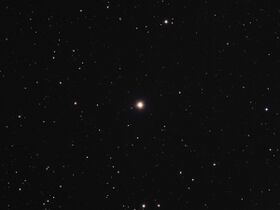Astronomy:42 Draconis
| Observation data Equinox J2000.0]] (ICRS) | |
|---|---|
| Constellation | Draco |
| Right ascension | 18h 25m 59.13734s[1] |
| Declination | +65° 33′ 48.5288″[1] |
| Apparent magnitude (V) | 4.82[2] |
| Characteristics | |
| Spectral type | K1.5 III[2] |
| B−V color index | 1.187 |
| Astrometry | |
| Radial velocity (Rv) | 32.17 ± 0.20 km/s |
| Proper motion (μ) | RA: 105.83 ± 0.21[1] mas/yr Dec.: -27.24 ± 0.28[1] mas/yr |
| Parallax (π) | 10.36 ± 0.20[1] mas |
| Distance | 315 ± 6 ly (97 ± 2 pc) |
| Absolute magnitude (MV) | –0.108 |
| Details[2] | |
| Mass | 0.879±0.050 M☉ |
| Radius | 21.76±0.43 R☉ |
| Luminosity | 142.55±5.77 L☉ |
| Surface gravity (log g) | 2.1±0.54 cgs |
| Temperature | 4,280±16 K |
| Metallicity [Fe/H] | −0.5 dex |
| Age | 13.19±1.92 Gyr |
| Other designations | |
| Database references | |
| SIMBAD | data |
| Exoplanet Archive | data |
| Extrasolar Planets Encyclopaedia | data |
42 Draconis (abbreviated 42 Dra), formally named Fafnir (/ˈfɑːvnər/ or /ˈfɑːfnɪər/),[3][4] is a 5th magnitude K-type giant star located approximately 315 light years away in the constellation of Draco. As of 2009, an extrasolar planet (designated 42 Draconis b, later named Orbitar) is thought to be orbiting the star.
Of spectral type K1.5III, the star has a mass similar to the Sun but with a radius 22 times greater. It is a metal-poor star with metallicity as low as 35% that of the Sun and its age is 9.49 billion years. It is the northern pole star of Venus.[5]
Nomenclature
42 Draconis is the star's Flamsteed designation. Following its discovery the planet was designated 42 Draconis b. In July 2014 the International Astronomical Union launched NameExoWorlds, a process for giving proper names to certain exoplanets and their host stars.[6] The process involved public nomination and voting for the new names.[7] In December 2015, the IAU announced the winning names were Fafnir for this star and Orbitar for its planet.[8]
The winning names were submitted by the Brevard Astronomical Society of Brevard County, Florida, United States .[9] Fafnir was a Norse mythological dwarf who turned into a dragon, it is also the name of a fictional planet in Larry Niven's known space universe of similar description, ('Draco' is Latin for 'dragon'); Orbitar is a contrived word paying homage to the space launch and orbital operations of NASA.[10]
In 2016, the IAU organized a Working Group on Star Names (WGSN)[11] to catalog and standardize proper names for stars. In its first bulletin of July 2016,[12] the WGSN explicitly recognized the names of exoplanets and their host stars approved by the Executive Committee Working Group Public Naming of Planets and Planetary Satellites, including the names of stars adopted during the 2015 NameExoWorlds campaign. This star is now so entered in the IAU Catalog of Star Names.[4]
Planetary system
42 Draconis b was discovered in 2009. It is an example of a super-Jupiter.[13] However, the existence of this planet was questioned in 2021.[14]
| Companion (in order from star) |
Mass | Semimajor axis (AU) |
Orbital period (days) |
Eccentricity | Inclination | Radius |
|---|---|---|---|---|---|---|
| b (Orbitar) (unconfirmed) | ≥3.88 ± 0.85 MJ | 1.19 ± 0.01 | 479.1 ± 6.2 | 0.38 ± 0.06 | — | — |
See also
References
- ↑ 1.0 1.1 1.2 1.3 1.4 van Leeuwen, F. (2007). "Validation of the new Hipparcos reduction". Astronomy and Astrophysics 474 (2): 653–664. doi:10.1051/0004-6361:20078357. Bibcode: 2007A&A...474..653V. http://www.aanda.org/index.php?option=com_article&access=bibcode&Itemid=129&bibcode=2007A%2526A...474..653VFUL. Vizier catalog entry
- ↑ 2.0 2.1 2.2 Ligi, R. et al. (February 2016), "Radii, masses, and ages of 18 bright stars using interferometry and new estimations of exoplanetary parameters", Astronomy & Astrophysics 586: 23, doi:10.1051/0004-6361/201527054, A94, Bibcode: 2016A&A...586A..94L.
- ↑ "Fafnir". Merriam-Webster Dictionary. https://www.merriam-webster.com/dictionary/Fafnir.
- ↑ 4.0 4.1 "IAU Catalog of Star Names". http://www.pas.rochester.edu/~emamajek/WGSN/IAU-CSN.txt.
- ↑ ""Is Polaris the north star for all the other planets just like it is for Earth?" | Planetarium | University of Southern Maine". https://usm.maine.edu/planet/polaris-north-star-all-other-planets-just-it-earth.
- ↑ NameExoWorlds: An IAU Worldwide Contest to Name Exoplanets and their Host Stars. IAU.org. 9 July 2014
- ↑ "NameExoWorlds The Process". http://nameexoworlds.iau.org/process.
- ↑ Final Results of NameExoWorlds Public Vote Released, International Astronomical Union, 15 December 2015.
- ↑ Website
- ↑ "NameExoWorlds The Approved Names". http://nameexoworlds.iau.org/names.
- ↑ "IAU Working Group on Star Names (WGSN)". https://www.iau.org/science/scientific_bodies/working_groups/280/.
- ↑ "Bulletin of the IAU Working Group on Star Names, No. 1". http://www.pas.rochester.edu/~emamajek/WGSN/WGSN_bulletin1.pdf.
- ↑ 13.0 13.1 Döllinger, M. P. et al. (2009). "Planetary companion candidates around the K giant stars 42 Draconis and HD 139 357". Astronomy and Astrophysics 499 (3): 935–942. doi:10.1051/0004-6361/200810837. Bibcode: 2009A&A...499..935D. http://www.aanda.org/articles/aa/full_html/2009/21/aa10837-08/aa10837-08.html.
- ↑ Döllinger, M. P.; Hartmann, M. (September 2021). "A Sanity Check for Planets around Evolved Stars". The Astrophysical Journal Supplement Series 256 (1): 10. doi:10.3847/1538-4365/ac081a. Bibcode: 2021ApJS..256...10D.
External links
- Jean Schneider (2011). "Notes for star 42 Dra". Extrasolar Planets Encyclopaedia. http://exoplanet.eu/star.php?st=42+Dra.
Coordinates: ![]() 18h 25m 59.1381s, +65° 33′ 48.530″
18h 25m 59.1381s, +65° 33′ 48.530″
 |


